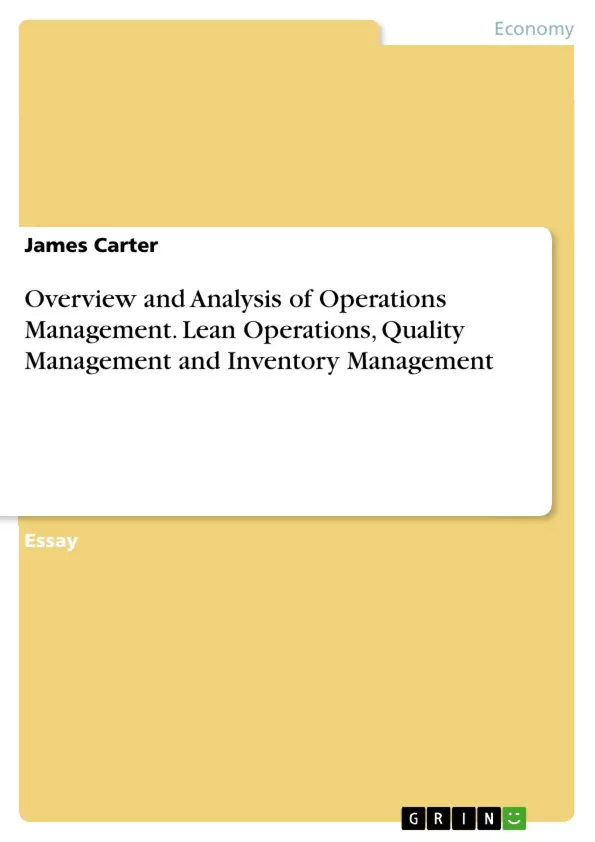This essay will analyse the key factors which determine ‘success’ and ‘failure’ of quality management (QM), lean operations and inventory management. These three areas of operations management are significant and can dramatically improve a firm’s efficiency, responsiveness and reduce costs.This essay will illustrate how theoretical frameworks can help explain the actions of organisations past and present, and the success of these actions will be evaluated.
Managers often fail to understand for operations to be successful, a company wide approach or cultural shift must occur. There is much literature on the application of these operations in a small number of sectors, namely, manufacturing. This essay will analyse the appropriateness of these operations across many sectors and will draw upon case studies as well as my own experience.
Table of Contents
- Quality Management
- Overview
- Analysis
- Conclusion
- Inventory Management
- Introduction
- Analysis
- Conclusion
- Lean Operations
- Introduction
- Analysis
- Conclusion
Objectives and Key Themes
This essay examines the key factors that contribute to the success or failure of quality management (QM), lean operations, and inventory management. These crucial aspects of operations management can significantly enhance a company's efficiency, responsiveness, and cost reduction efforts. The essay explores how theoretical frameworks can provide insights into the actions of organizations, both past and present, and evaluates the success of these actions. It emphasizes the importance of a company-wide approach and cultural shift for successful operations.- The impact of quality management, lean operations, and inventory management on organizational success
- The application of theoretical frameworks to explain organizational actions and their outcomes
- The role of a company-wide cultural shift in achieving operational excellence
- The significance of leadership and management commitment in implementing these operational strategies
- The applicability of these operations across various sectors, with a focus on manufacturing and beyond
Chapter Summaries
Quality Management
This chapter provides an overview of quality management (QM) as a company-wide approach to continuous improvement, aiming to produce high-quality products at lower costs. It explores the evolution of QM, highlighting its rise in popularity in America during the 1980s due to competition from Japanese firms. The chapter then delves into different definitions and dimensions of quality, drawing on Garvin's (1984) work. Key elements discussed include Total Quality Management (TQM) and its principles, Deming's 14 points for increasing competitiveness, and Juran's (1993) perspective on customer-centricity. Examples from Ford Motor Company and Motorola's Six Sigma illustrate the practical application of QM strategies.Inventory Management
This chapter defines inventory as a stock of items maintained to meet customer demand and explains its financial and operational importance to businesses. It emphasizes the need for a balance between low inventory levels and maximizing return on investment (ROI). The chapter explores the costs associated with inventory, including carrying costs and stock-out costs, and discusses how inventory management can improve customer service and profit margins. It highlights the importance of top-level management commitment, education, and training for successful inventory management implementation.Lean Operations
This chapter explores lean operations as a systematic approach to eliminate waste and maximize value in production processes. It emphasizes the importance of identifying and eliminating non-value-adding activities to enhance efficiency and effectiveness. The chapter delves into the principles of lean operations, including value stream mapping, just-in-time (JIT) production, and continuous improvement. It explores how lean operations can contribute to improved customer satisfaction, reduced costs, and increased competitiveness.Keywords
This essay focuses on key concepts and terms related to quality management, lean operations, and inventory management. These include: * Total Quality Management (TQM) * Six Sigma * Lean Operations * Inventory Management * Customer Satisfaction * Efficiency * Cost Reduction * Competitiveness * Cultural Shift * Leadership Commitment * Value Stream Mapping * Just-in-Time (JIT) Production * Waste Elimination * Continuous Improvement- Citar trabajo
- James Carter (Autor), 2013, Overview and Analysis of Operations Management. Lean Operations, Quality Management and Inventory Management, Múnich, GRIN Verlag, https://www.grin.com/document/230335



